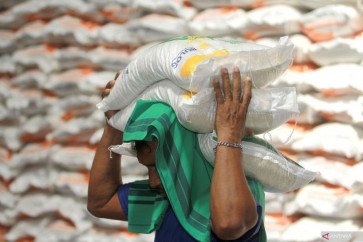Popular Reads
Top Results
Can't find what you're looking for?
View all search resultsPopular Reads
Top Results
Can't find what you're looking for?
View all search resultsTracking the long, spicy journey of shallots
Key commodity: A farmer shows off his shallot harvest in Brebes regency, Central Java
Change text size
Gift Premium Articles
to Anyone
K
span class="caption">Key commodity: A farmer shows off his shallot harvest in Brebes regency, Central Java. Shallot farming is the bread and butter of many residents in Brebes, which accounts for more than a third of Indonesia’s shallot production.(JP/ADT)
Despite their tiny shape, shallots have long played an important part in Indonesia’s culinary traditions. As a key ingredient for many Indonesian dishes, shallots are a must-buy item for millions of households. Although the country has maintained shallot self-sufficiency for years, the price of the commodity keeps fluctuating throughout the year and peaks ahead of and during festive seasons, such as Idul Fitri. To track down the journey of the spice from farmland to kitchen, The Jakarta Post’s Radhitya Diva Putra recently visited the Central Java regency of Brebes, the country’s largest shallot-producing region, to talk to farmers, middlemen and vendors and observe how wide gaps in access to distribution channels have apparently become the main source of the pricing problem.
Frequent shallot customers in Jakarta may find it irritating to see the soaring price of the commodity, particularly in recent weeks during the Ramadhan fasting month.
Earlier this month, shallot vendors at traditional markets in the capital city traded their product for no less than Rp 44,000 (US$3.30) per kilogram. Although the price has dropped to around Rp 37,000 per kg since the weekend, that is still almost 50 percent higher than the average price recorded in January.
As such patterns emerge each annual cycle, with the price peaking ahead of the Islamic Idul Fitri holiday, the question is: why are shallot prices so unstable?
“We often complain to market supervisors about the fluctuating price of shallots, but we never get any satisfying answers,” Wahyuni, a vegetable and spice vendor at East Jakarta’s Kramat Jati market, said recently.
Without any clear information about the way shallot prices are determined, Wahyuni said she and many other retail vendors frequently took the blame from disgruntled customers for sudden price hikes.
Known for its strong and spicy flavor, shallots are a basic ingredient for almost all Indonesian dishes. Used in everything from the ever-popular Padang food and fried rice, to various kinds of sambal (chili condiment), shallot as a key element in Indonesian cooking.
Data from the Agriculture Ministry shows that Indonesia’s shallot consumption hit 950,000 tons last year and is expected to grow to slightly over 1 million tons by 2019. While a few regions are able to fulfil the demand for shallots from local production alone, many others, including Jakarta, have been relying heavily on supply from the Central Java regency of Brebes, the country’s largest shallot-producing region.
Located some 300 kilometers east of Jakarta, Brebes produced almost 40 percent of Indonesia’s shallots last year, which stood at 1.2 million tons. Despite reliable road infrastructure connecting the two cities, the wide disparity between shallot prices paid to farmers in Brebes and charged by retailers in Jakarta indicates an inefficient supply chain that has resulted in the unstable price of the commodity.

In a recent visit to Brebes, The Jakarta Post learned that many local farmers sell their newly harvested shallots to middlemen for only up to Rp 20,000 per kilogram, way below its retail price in Jakarta and many other cities.
Kaspuri, who owns a 3-hectare shallot farm in Klampok subdistrict, said most farmers in the regency, including him, had no direct access to the distribution chain, leaving them with the sole option of selling their products to middlemen.
Through the middlemen, farmers sell their products under one of two schemes: at a negotiated price after the shallots are ripe or letting the middlemen pay in advance for their young plants, locally known as an ijon system.
A local farmers’ association estimates that around 90 percent of shallot transactions in Brebes are made through the second scheme. “Both options distance us from retailers and our end buyers,” Kaspuri said.
Despite the relatively short production cycle of shallots, growing the plant on a massive scale can be a very tricky job. It needs, for instance, to be carefully watered once every two days until it is ready for harvest seven weeks later.
Although shallots can be grown throughout the year, they have their best yields during dry season. In rainy seasons, production usually flops due to the plant’s overexposure to water, making it rot easily. In terms of quality, shallots harvested in dry season are also much better than those in dry season.
Kaspuri, for example, said he could produce 20 tons of shallots in each harvest during dry season. The figure nosedives, however, by around 50 percent in the rainy season.
Raniman, 45, another local farmer, said the high-risk shallot production business had led many farmers to opt for the ijon system, which helps them avoid losses in case of harvest failure. Under the system, middlemen speculatively buy unripe shallots and move them to their farmland until they are ready for harvest.
“Last month, Cahaya Anugerah, the regency’s biggest middleman, paid for almost all the shallots in my farmland through this ijon system,” said Raniman, referring to PT Cahaya Anugerah Abadi Sejahtera, a local firm that distributes the commodity to domestic and overseas markets.
For every 10 ha of shallots, Raniman said a middleman usually offered Rp 50 million to Rp 100 million, depending on the season.
The Post managed to visit Cahaya Anugerah’s warehouse on Jl. Klampok KM 51 and spoke to a number of workers, who claimed that the company had been implementing a number of strategies to control shallot prices, including withholding supplies to other regions during harvest seasons.
If stored properly, shallots can last for more than six months, the workers said. By holding back supplies, prices increase allowing the company to multiply profit by pouring its stockpiled shallots into the market.
Cahaya Anugerah owner Benny Santoso admitted that that his firm practiced this hold-and-sell strategy. He denied, however, allegations that the practice was solely aimed at increasing profit.
Benny argued that when shallot prices were high in the market, his firm made a higher profit, thus enabling it to provide farmers with various incentives, such as seeds, fuel and other supporting facilities. On the contrary, when prices are low, the firm and farmers can only manage regular trading activities.
“This stockpiling strategy is not only aimed at maximizing profit, but also for a much larger cause: helping farmers achieve prosperity,” he said.

Established in 1983 as a family business, Cahaya Anugerah currently distributes shallots to cities outside Java and a number of Asian countries, such as Malaysia, Thailand and China. In total, the company distributes over 200,000 tons of shallots annually, around half of Brebes’ annual shallot production, Benny said.
The dominant, long-standing role of Brebes-based middlemen in controlling supply channels for shallots might also be attributed to the fact that they abide by an unwritten rule that one should not expand into another’s market.
Benny, for example, does not cater to markets in Jakarta and West Java, the country’s most populated province, as other major suppliers, like Paulus Silalahi and Muhammad Nasir, have been running established operations in the regions.
Pratiwi Wulandari, a shallot wholesaler at the Kramat Jati central market in East Jakarta, said she got her regular supplies from a number of middlemen, including Paulus and Nasir, who also arranged the transportation of the commodity from Brebes.
Pratiwi said she currently paid Rp 25,000 per kg of shallot and sold them to retailers for Rp 30,000.
Nugroho, another wholesaler, quoted similar figures, adding that he could sell at least 500 kg of shallots every day.
“Most of my consumers are retailers from traditional markets. Each of them buys between 25 and 40 kg of shallots every day,” he said.
Based on the current shallot retail price, retailers in Jakarta’s traditional markets add Rp 7,000 per kg to their own purchase price to cover costs and make a profit.
In cities further away from Jakarta, the end price of Brebes-grown shallots are indeed more expensive. In Manado, North Sulawesi, the price of shallots has recently reached Rp 50,000 per kg in local supermarkets. Meanwhile in Aceh, the country’s westernmost province, the levels can be much higher during the rainy season.
“Between August and November, shallot prices usually jumps by 100 percent from normal levels as many farmlands in Java are inundated with floods,” said Wanda, a wholesaler in Pasar Lambaro market in Aceh Besar regency.
In response to the soaring prices of key commodities like beef and shallots during Ramadhan, the Trade Ministry, the Agriculture Ministry, the Cooperatives and Small and Medium Enterprises Ministry and the Industry Ministry agreed earlier this month to establish a joint team to monitor and stabilize food prices as well as prevent foul play at any stage of supply chains.
The team will continue to work beyond Idul Fitri, which falls on July 6, to ensure “efficient and effective” supply chains from farmers to consumers.
Separately, the Institute for Development of Economic and Finance (Indef) director Enny Sri Hartati said the distribution margins charged by shallot middlemen, wholesalers and retailers, which ranged from Rp 5,000 to Rp 7,000, were “irrational”.
“Wholesalers in central markets, for instance, only need to spend money on collecting the shallots and renting the space,” she said.
Cutting the shallots supply chain also will not help much, Enny said, instead suggesting the government make a strict regulation about profit margins.
“The existing system makes end-consumers bear all the costs,” she said.
— Hotli Simanjuntak in Banda Aceh and Lita Aruperes in Manado contributed to this article










